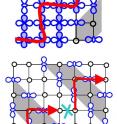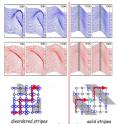A manganite changes its stripes
Related images
(click to enlarge)
If there were a Hall of Fame for materials, manganites would be among its members. Some manganites, compounds of manganese oxides, are renowned for colossal magnetoresistance – the ability to suddenly boost resistance to electrical conductivity by orders of magnitude when a magnetic field is applied – and manganites are also promising candidates for spintronics applications – devices that can manipulate electrons according to their quantum spin as well their charge. What's not particularly unusual about manganites, however, is that they have stripes, regions where the material's electrical charges gather and concentrate. Other so-called correlated-electron materials also have stripes, including many high-temperature superconductors having the same crystal structure: arrangements of layers of atoms named for the mineral perovskite.
Now a team of researchers from the University of Colorado at Boulder, the U.S. Department of Energy's Lawrence Berkeley National Laboratory (Berkeley Lab), and Argonne National Laboratory have used the technique of angle-resolved photoelectron spectroscopy (ARPES), at beamline 12.0.1 at Berkeley Lab's Advanced Light Source, to demonstrate a startling new feature of one kind of lanthanum strontium manganese oxide.
This "two-dimensional bilayer manganite" can change its stripes from fluctuating to static and back. As a result, at the right temperature it switches from a metallic state, a good conductor of electricity, to an insulator – a colossal change in conductivity. The researchers report their results in Proceedings of the National Academy of Sciences (PNAS).
New stripes versus old
"Self-organization of charges into static stripes isn't new, but as far as we know this is the first good insight into what happens to the electronic properties of a material when stripes 'fluctuate' – in other words, break their perfect order – and fracture to pieces," says Alexei Fedorov, staff scientist for ALS beamline 12.0.1 and a co-author of the PNAS paper. "It establishes the existence of a distinct new phase of the material, which we call fluctuating bi-stripes."
Unlike the stripes in some high-temperature superconductors, in which the electrons move freely, the electrons in the manganite bi-stripes are frozen in place. Electrons not trapped inside a stripe are free to move, but when the stripes are lined up side by side, all the way across the crystal, free electrons are stymied at every turn.
The bilayer compound used in the study has the formula La2-2xSr1+2xMn2O7. The x's in the formula indicate the degree of positive doping, the introduction of additional positive charge carriers or holes (in fact, the absence of electrons), which markedly affect how the compound behaves.
Previous studies of lanthanum strontium manganese oxides focused on low to medium doping levels, where the sample behaves either as a ferromagnetic metal or an anti-ferromagnetic insulator. (Ferromagnetism is the kind of magnetism displayed by iron, which can be magnetized by a magnetic field applied from outside and can retain that magnetism.) The new study was conducted at higher doping over a range of temperatures, where earlier x-ray scattering experiments had observed static stripes.
"Static bi-stripes have a wider spacing and only occur at higher temperatures," says Fedorov. "It sounds counterintuitive, but below the critical temperature the bi-stripes 'melt,' and instead of forming long parallel bands they become disordered." The disordered stripes exist as broken fragments, allowing free electrons to find a path among them.
Detecting disordered or "fluctuating stripes" is tricky. ARPES can detect their presence, but x-ray scattering, which reconstructs an image from x-rays diffracted by atoms of specific elements in the sample, doesn't see them individually; rather it responds to their periodicity. Since there's no periodicity in the "melted" stripes of highly doped La2-2xSr1+2xMn2O7, the scattering signal quickly disappears below the temperature at which the static bi-stripes disappear.
How to catch stripes in the act
ARPES can see both kinds of stripes because it draws a spectrum of electronic states directly, when a bright beam of soft x-rays from ALS beamline 12.0.1 falls on the sample and excites the electrons into the vaccum. These electrons are caught by a detector that measures their kinetic energy and direction. From this data the electronic structures in the sample can be identified.
The remarkable ability to turn the conductivity of properly doped bilayer manganite on and off just by adjusting its temperature a few degrees holds obvious promise. The bi-stripes act like electronic valves and could be used to tune various materials – perhaps even high-temperature superconductors – by altering the material's stripe structure.
"We're after smart materials," says Fedorov. "We need them for all kinds of reasons – for example, for electronic devices so energy efficient that they can run on a lighter batteries or fewer solar cells. In this area, applications are already getting ahead of what we comprehend – for example, colossal magnetoresistance or high-temperature superconductivity. To make real progress, it's important that we understand the physics of highly correlated materials."
The physical picture of bilayer manganite the researchers have come up with shows how electrons can hop from manganese atom to manganese atom. Some of these atoms lack three electrons (Mn3+) and others lack four (Mn4+), and at low temperature the free electrons alternate from one to the next as they find paths through the disordered landscape. But at high temperature the stripes line up – and the gaps between them are wider, accommodating an extra row of Mn4+ atoms, as a result of the extra hole doping. Electrons can't negotiate these irregularly spaced "stepping stones."
For the success of the team's work, Fedorov credits a long history of manganite research by the University of Colorado physicists, Zhe Sun and Quinn Wang, led by Daniel Dessau; the high-quality manganite samples made by Jennifer Hong Zheng and group leader John Mitchell from Argonne; and finally the characteristics of the 12.0.1 beamline, which was built for ARPES. He says, "The beamline was recently upgraded for greater photon flux, improved resolution, and excellent sample positioning, and" – because experiments that rely on temperature change need a good vacuum – "the stable vacuum environment, which made this study possible."
Source: DOE/Lawrence Berkeley National Laboratory
Other sources
- A manganite changes its stripes: Advanced Light Source uncovers colossal conductivity changes in a special materialfrom Science DailySat, 16 Jul 2011, 3:30:20 UTC
- A manganite changes its stripesfrom PhysorgFri, 15 Jul 2011, 14:00:34 UTC

